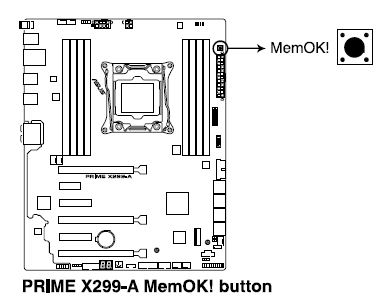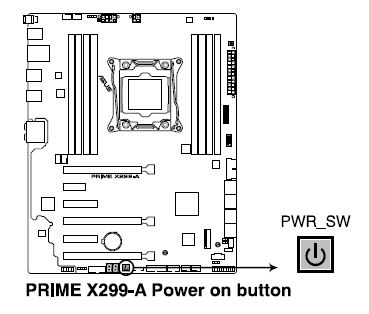Onboard Switches
and Buttons
The board contains
the following buttons and switches that can be used to control
board operation in order to fine-tune performance when working
on a bare or open-case system. This is ideal for overclockers
and gamers who continually change settings to enhance system performance:
MemOK!
button BIOS
Flashback button Power-on
button |
MemOK!
Button
Installing DIMMS that are incompatible with
the motherboard may cause system boot
failure. If the system fails to boot during the POST stage and the
DRAM_LED near the MemOK! button lights continuously, press and hold the
MemOK! switch until the DRAM_LED starts blinking to begin automatic memory
compatibility tuning and reboot for successful boot.

 |
The
DRAM_LED also lights up when the DIMM is not properly installed.
Turn off the system and reinstall the DIMM before using the
MemOK! function. The
MemOK! button does not function under Windows® OS
environment. During
the tuning process, the system loads and tests failsafe memory
settings. It takes about 30 seconds for the system to test
one set of failsafe settings. If the test fails, the system
reboots and test the next set of failsafe settings. The blinking
speed of the DRAM_LED increases, indicating different test
processes. Due
to memory tuning requirement, the system automatically reboots
when each timing set is tested. If the installed DIMMs still
fail to boot after the whole tuning process, the DRAM_LED
lights continuously. Replace the DIMMs with ones recommended
in the Memory QVL (Qualified Vendors Lists) at www.asus.com. If
you turn off the computer and replace DIMMs during the tuning
process, the system continues memory tuning after turning
on the computer. To stop memory tuning, turn off the computer
and unplug the power cord for about 5–10 seconds. If your system
fails to boot up due to BIOS overclocking, press the MemOK!
Button to boot and load the BIOS default settings. A message
will appear during POST reminding you that the BIOS has been
restored to its default settings. |
USB BIOS Flashback Button
USB BIOS Flashback allows you to easily
update the BIOS without entering the BIOS or operating system. Just
connect the USB storage device containing the BIOS file into the USB port,
press USB BIOS Flashback button for three seconds, and the BIOS is updated
automatically.

To
use USB BIOS Flashback:
1. Insert the USB
storage device into the USB BIOS Flashback port.
•
We recommend the use of a USB 2.0 storage device to save the latest BIOS
version for better compatibility and stability.
2. Rename the file
as X299A.CAP, then copy it to your USB storage device.
3. Shut down your
computer.
4. Press the BIOS
Flashback button for three seconds until the Flashback LED blinks three
times, indicating that the BIOS Flashback function is enabled.
5. Wait until the
light goes out, indicating that the BIOS updating process is completed.
 |
Do not unplug portable disk, power
system, or press the CLR_CMOS button while BIOS update is
ongoing, otherwise the update will be interrupted. In case
of interruption, please follow the steps again. If the
light flashes for five seconds and turns into a solid light,
this means that the BIOS Flashback is not operating properly.
This may be caused by improper installation of the USB storage
device and filename/file format error. If this scenario happens,
please restart the system to turn off the light. Updating the BIOS has risks. If
the BIOS program is damaged during the process and results
in the system’s failure to boot up, please contact the Northern
Micro Service Department. |
Power-On Button
The motherboard comes with a power-on button
that allows you to power up or wake up the system. The button also lights
up when the system is plugged to a power source indicating that you should
shut down the system and unplug the power cable before removing or installing
any motherboard component.


